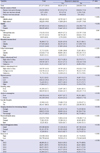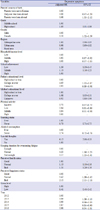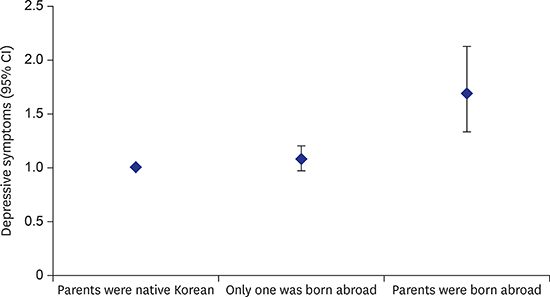1. Arnett JJ. The psychology of globalization. Am Psychol. 2002; 57(10):774–783.

2. Chen SX, Benet-Martínez V, Harris Bond M. Bicultural identity, bilingualism, and psychological adjustment in multicultural societies: immigration-based and globalization-based acculturation. J Pers. 2008; 76(4):803–838.

3. Castles S, de Haas HG, Miller MJ. The Age of Migration: International Population Movements in the Modern World. 5th ed. New York, NY: Palgrave Macmillan;2013.
6. Lee HK. International marriage and the state in South Korea: focusing on governmental policy. Citizensh Stud. 2008; 12(1):107–123.

9. Gibbs JT, Moskowitz-Sweet G. Clinical and cultural issues in the treatment of biracial and bicultural adolescents. Fam Soc. 1991; 72(10):579–592.

10. Brown PM. Biracial identity and social marginality. Child Adolesc Social Work J. 1990; 7(4):319–337.

11. Gibbs JT, Huang LN. Children of Color: Psychological Interventions with Minority Youth. San Francisco, CA: Jossey-Bass;1991.
12. Cheng S, Lively KJ. Multiracial self-identification and adolescent outcomes: a social psychological approach to the marginal man theory. Soc Forces. 2009; 88(1):61–98.

13. Udry JR, Li RM, Hendrickson-Smith J. Health and behavior risks of adolescents with mixed-race identity. Am J Public Health. 2003; 93(11):1865–1870.

14. Allen JP, Hauser ST, Bell KL, O'Connor TG. Longitudinal assessment of autonomy and relatedness in adolescent-family interactions as predictors of adolescent ego development and self-esteem. Child Dev. 1994; 65(1):179–194.

15. Desjarlais R. World Mental Health: Problems and Priorities in Low-income Countries. New York, NY: Oxford University Press;1995.
16. World Health Organization. Preamble to the Constitution of the World Health Organization as Adopted by the International Health Conference, New York, 19??2 June, 1946. Geneva, Switzerland: World Health Organization;1948..
17. Mathers C, Fat DM, Boerma JT. The Global Burden of Disease: 2004 Update. Geneva, Switzerland: World Health Organization;2008.
18. Cavanagh JT, Carson AJ, Sharpe M, Lawrie SM. Psychological autopsy studies of suicide: a systematic review. Psychol Med. 2003; 33(3):395–405.

19. Organisation for Economic Co-operation and Development. Society at a Glance 2016: OECD Social Indicators. Paris, France: OECD Publishing;2016.
20. Kim JL, Cho J, Park S, Park EC. Depression symptom and professional mental health service use. BMC Psychiatry. 2015; 15:261.

21. Campbell ME, Eggerling-Boeck J. “What about the children?” The psychological and social well-being of multiracial adolescents. Sociol Q. 2006; 47(1):147–173.

22. Bae J, Joung H, Kim JY, Kwon KN, Kim Y, Park SW. Validity of self-reported height, weight, and body mass index of the Korea Youth Risk Behavior Web-based Survey questionnaire. J Prev Med Public Health. 2010; 43(5):396–402.

23. Bae J, Joung H, Kim JY, Kwon KN, Kim YT, Park SW. Test-retest reliability of a questionnaire for the Korea Youth Risk Behavior Web-based Survey. J Prev Med Public Health. 2010; 43(5):403–410.

24. Stevens GW, Vollebergh WA. Mental health in migrant children. J Child Psychol Psychiatry. 2008; 49(3):276–294.

25. Bursztein Lipsicas C, Henrik Mäkinen I. Immigration and suicidality in the young. Can J Psychiatry. 2010; 55(5):274–281.

26. Kim JH, Kim JY, Kim SS. School violence, depressive symptoms, and help-seeking behavior: a gender-stratified analysis of biethnic adolescents in South Korea. J Prev Med Public Health. 2016; 49(1):61–68.

27. Bourque F, van der Ven E, Malla A. A meta-analysis of the risk for psychotic disorders among first-and second-generation immigrants. Psychol Med. 2011; 41(5):897–910.
28. Angold A. Childhood and adolescent depression. I. Epidemiological and aetiological aspects. Br J Psychiatry. 1988; 152(5):601–617.
29. Goodman E, Slap GB, Huang B. The public health impact of socioeconomic status on adolescent depression and obesity. Am J Public Health. 2003; 93(11):1844–1850.

30. Lee S, Hong JS, Espelage DL. An ecological understanding of youth suicide in South Korea. Sch Psychol Int. 2010; 31(5):531–546.

31. Jeon W, Hong C, Lee C, Kim DK, Han M, Min S. Correlation between traumatic events and posttraumatic stress disorder among North Korean defectors in South Korea. J Trauma Stress. 2005; 18(2):147–154.

32. Moon S. Multicultural and global citizenship in a transnational age: the case of South Korea. Int J Multicult Educ. 2010; 12(1):1–15.

33. Kim AE. Global migration and South Korea: foreign workers, foreign brides and the making of a multicultural society. Ethn Racial Stud. 2009; 32(1):70–92.

34. Borrell C, Muntaner C, Gil-González D, Artazcoz L, Rodríguez-Sanz M, Rohlfs I, et al. Perceived discrimination and health by gender, social class, and country of birth in a Southern European country. Prev Med. 2010; 50(1-2):86–92.

35. Hagan MJ, Roubinov DS, Adler NE, Boyce WT, Bush NR. Socioeconomic adversity, negativity in the parent child-relationship, and physiological reactivity: an examination of pathways and interactive processes affecting young children's physical health. Psychosom Med. 2016; 78(9):998–1007.

36. Smith A, Lalonde RN, Johnson S. Serial migration and its implications for the parent-child relationship: a retrospective analysis of the experiences of the children of Caribbean immigrants. Cultur Divers Ethnic Minor Psychol. 2004; 10(2):107–122.

37. Berry JW. Multicultural policy in Canada: a social psychological analysis. Can J Behav Sci. 1984; 16(4):353–370.

38. Alba R. Immigration and the American realities of assimilation and multiculturalism. Sociol Forum (Randolph N J). 1999; 14(1):3–25.
39. Joppke C. Multiculturalism and immigration: a comparison of the United States, Germany, and Great Britain. Theory Soc. 1996; 25(4):449–500.

40. Vertovec S. Introduction: new directions in the anthropology of migration and multiculturalism. Ethn Racial Stud. 2007; 30(6):961–978.









 PDF
PDF Citation
Citation Print
Print




 XML Download
XML Download